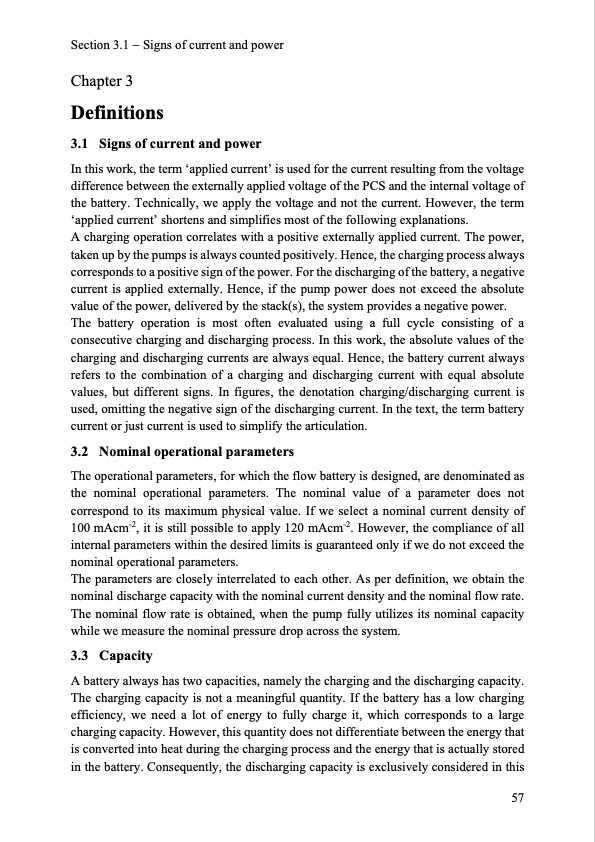
PDF Publication Title:
Text from PDF Page: 065
Section 3.1 Signs of current and power Chapter 3 Definitions Definitions 3.1 Signs of current and power In this work, the term ‘applied current’ is used for the current resulting from the voltage difference between the externally applied voltage of the PCS and the internal voltage of the battery. Technically, we apply the voltage and not the current. However, the term ‘applied current’ shortens and simplifies most of the following explanations. A charging operation correlates with a positive externally applied current. The power, taken up by the pumps is always counted positively. Hence, the charging process always corresponds to a positive sign of the power. For the discharging of the battery, a negative current is applied externally. Hence, if the pump power does not exceed the absolute value of the power, delivered by the stack(s), the system provides a negative power. The battery operation is most often evaluated using a full cycle consisting of a consecutive charging and discharging process. In this work, the absolute values of the charging and discharging currents are always equal. Hence, the battery current always refers to the combination of a charging and discharging current with equal absolute values, but different signs. In figures, the denotation charging/discharging current is used, omitting the negative sign of the discharging current. In the text, the term battery current or just current is used to simplify the articulation. 3.2 Nominal operational parameters The operational parameters, for which the flow battery is designed, are denominated as the nominal operational parameters. The nominal value of a parameter does not correspond to its maximum physical value. If we select a nominal current density of 100 mAcm-2, it is still possible to apply 120 mAcm-2. However, the compliance of all internal parameters within the desired limits is guaranteed only if we do not exceed the nominal operational parameters. The parameters are closely interrelated to each other. As per definition, we obtain the nominal discharge capacity with the nominal current density and the nominal flow rate. The nominal flow rate is obtained, when the pump fully utilizes its nominal capacity while we measure the nominal pressure drop across the system. 3.3 Capacity A battery always has two capacities, namely the charging and the discharging capacity. The charging capacity is not a meaningful quantity. If the battery has a low charging efficiency, we need a lot of energy to fully charge it, which corresponds to a large charging capacity. However, this quantity does not differentiate between the energy that is converted into heat during the charging process and the energy that is actually stored in the battery. Consequently, the discharging capacity is exclusively considered in this 57PDF Image | Model-based Design Vanadium Redox Flow Batteries

PDF Search Title:
Model-based Design Vanadium Redox Flow BatteriesOriginal File Name Searched:
10-5445IR1000070670.pdfDIY PDF Search: Google It | Yahoo | Bing
Salgenx Redox Flow Battery Technology: Salt water flow battery technology with low cost and great energy density that can be used for power storage and thermal storage. Let us de-risk your production using our license. Our aqueous flow battery is less cost than Tesla Megapack and available faster. Redox flow battery. No membrane needed like with Vanadium, or Bromine. Salgenx flow battery
| CONTACT TEL: 608-238-6001 Email: greg@salgenx.com | RSS | AMP |